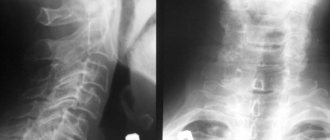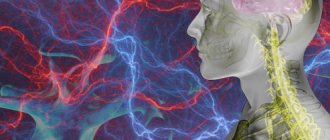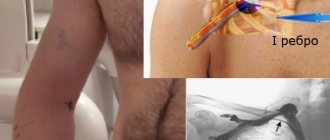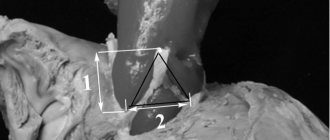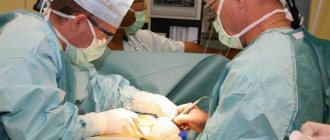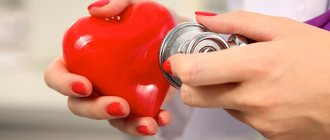Once you master the whole complex, you won’t need medications.
by rehabilitation therapist Alexander Shishonin will help reduce blood pressure and get rid of headaches
— Often, hypertension is a consequence of cervical osteochondrosis, when the first cervical vertebra, the atlas, is displaced and compresses the vessels supplying the brain. The brain receives little oxygen and instructs the heart to increase the strength and frequency of heart contractions. The pressure rises and blood flow to the brain increases. As a result, hypertension develops.
In this case, it is useless to take pills. It is necessary to strengthen the neck muscles in order to eliminate instability of the atlas (less often, of another cervical vertebra) and to free the vessels compressed by the vertebrae and spasmed by the muscles. Then the pressure will return to normal. The simplest gymnastics that you can do at home will help with this.
It's the same with chronic headaches. They are often caused by tension and spasm in the neck muscles. Especially if a person is constantly under stress: he instinctively presses his head into his shoulders to protect himself. As a result, blood microcirculation and nutrition of surrounding tissues are disrupted, intervertebral discs and ligaments are weakened, the vertebrae become unstable and compress the blood vessels.
To understand whether blood flow through the vertebral arteries is impaired, you need to do an ultrasound. If vascular compression is confirmed, you can begin gymnastics.
At first, it is better to practice while sitting in front of a mirror to control every movement.
Three exercises with warm-up and stretching are express gymnastics. The full set contains 12 exercises. You can find them on the website “Club of Former Hypertensive Patients”
You can perform gymnastics every day or every other day. However, if after a month after classes you do not feel significantly better, you should seek professional help. Perhaps the vertebra or vessel is located atypically. This means that a universal option is not suitable.
What is hypertension and why is it dangerous?
Blood pressure (BP) values show how much pressure the blood exerts on the walls of blood vessels when the heart contracts and relaxes.
If the values on the tonometer show figures of 140/90 mm Hg or more, this indicates an increase in blood pressure, and if this condition persists for a long time, it indicates hypertension [1]. Hypertension can occur independently or develop as a consequence of other pathologies - in this case, secondary hypertension develops. If the cause of high blood pressure cannot be eliminated, the disease is chronic and, without proper treatment, constantly progresses [1]. The danger of hypertension lies not in the fact of increased pressure, but in the consequences of this condition. Pathology significantly increases the risk of dangerous cardiovascular disorders - cardiac failure, arrhythmia, heart attack and stroke [2]. Also, against the background of a prolonged increase in blood pressure, damage to the heart, brain structures, kidney vessels, and eyes occurs [1]. A sharp rise in pressure (in some cases - up to 200/120 mm Hg and above) is dangerous due to the risk of a hypertensive crisis - a set of symptoms that develop due to overstrain of the circulatory system at a time of high blood pressure (Fig. 1). This condition can be life-threatening - heart attacks and strokes most often occur precisely at the time of a hypertensive crisis [3].
Figure 1. Signs of a hypertensive crisis. Source: MedPortal
At the same time, the symptoms of hypertension may not appear for a long time - the pathology is called the “silent killer”, since patients often do not measure their blood pressure for years and, accordingly, are not aware of its increase. As the condition worsens, signs of the disease may appear, such as:
- weakness;
- headaches, especially in the morning;
- causeless nosebleeds;
- arrhythmias - complaints of palpitations, irregular heart function;
- deterioration of vision - “loss” of areas of vision, flashing “dots” before the eyes;
- tinnitus.
An intense increase in blood pressure is often accompanied by loss of energy, facial flushing, nausea and vomiting, sweating, anxiety, varying degrees of impaired consciousness, chest pain and other symptoms, but in some cases even a hypertensive crisis can occur asymptomatically [2].
Important! The only way to determine and assess the course of hypertension is to measure blood pressure, so people with this diagnosis need not only to be regularly monitored by a therapist or cardiologist, but also to independently monitor their blood pressure [2].
Treatment of the pathology depends on the type of hypertension - if the pressure rises due to other diseases, it is necessary first of all to restore dysfunction of these organs, and in the primary form of the pathology (hypertension), blood pressure can be normalized only with the help of constant medication and non-drug therapy [2; 3].
How are the human neck and blood pressure related?
The vertebrae of the cervical spine are one of the most mobile parts of the human spine. Thanks to them, a person performs numerous turns of the head from side to side, as well as circular movements with it.
Due to heavy physical activity, the cervical elements of the spine are one of the most vulnerable parts of the human axial skeleton
There are only seven cervical vertebrae in the human body. With osteochondrosis, they often compress the main artery of the axial skeleton, which is responsible for delivering blood to the responsible parts of the brain. As a result, the latter instantly receives a signal about hypoxia, and the human body concentrates as much as possible on preventing oxygen starvation of the most important organ. Vascular tone increases, blood flow increases, and normal blood pressure levels increase.
In most cases, when osteochondrosis suddenly appears, people do not pay close attention to the emerging disease; they neglect treatment and continue to live peacefully. Over time, even the appearance of hypertension becomes normal for them. But in fact, pain in the spine and a diagnosis such as high blood pressure are worth fighting to prevent the development of more serious complications in the future.
In order to cure hypertension, restore the circulation of biological substrates in the body and eliminate deformation of the vessels of the cervical spine, many specialists, in addition to prescribing pills and using any other methods of treatment, recommend their patients to regularly do Alexander Shishonin’s gymnastics.
Conservative treatment for hypertension
To normalize high blood pressure, doctors select drug treatment for patients with hypertension. First of all, the specialist should prescribe a drug from the group of antihypertensive drugs or even a combination of several medications - the choice depends on age, the degree of increase in blood pressure and the stage of the disease.
There are 5 main classes of drugs against hypertension; they are aimed at blocking certain enzymes, ions or receptors of biologically active substances that are involved in the pathogenesis of increased blood pressure. Also included in the list of “first-line” drugs are diuretics - diuretics reduce the volume of blood, as well as intercellular fluid, which reduces the load on the heart and stabilizes pressure in the blood vessels.
It is important for patients to adhere to the rules for treating hypertension, which are relevant in all situations, regardless of the medications prescribed:
- carry out all medical prescriptions;
- Constantly carry out self-monitoring of blood pressure;
- take medications regardless of the numbers on the tonometer - therapy for hypertension is permanent;
- Do not stop taking medications or change dosages on your own [5].
Self-monitoring your blood pressure helps you avoid serious problems caused by hypertension.
Photo: prostooleh - ru.freepik.com Correction of hypertension is not limited to the use of antihypertensive drugs and includes lifestyle changes, stress management and physiotherapy treatments. Therapeutic exercises are also included in the list of mandatory activities for hypertension - special exercises have a multifaceted restorative effect on the body of such patients [4].
How to measure blood pressure using a mechanical tonometer
In order to measure pressure with a mechanical tonometer, you need:
- sit in a comfortable position and relax, while your arm should be bent at the elbow joint and lie on a flat surface,
- remove the shoulder part of the arm from clothing and fasten the cuff on it (its lower edge should be 3-4 cm above the elbow bend),
- place a stethoscope (phonendoscope) on the inside of the elbow joint in the place where the pulse can best be felt,
- using a hand pump, start pumping air into the cuff,
- bring the pressure gauge needle to values exceeding the expected pressure by 30-40 mm. rt. Art. (for example, if the patient’s normal blood pressure is 135/90, then you can stop at 170),
- slowly release air from the cuff, waiting for tones to appear - these are the sounds of a heartbeat; their appearance marks the boundary of systolic pressure, and their disappearance marks the boundary of diastolic pressure. Simply put, if tones appeared at number 150 and disappeared at number 100, then the result is 150/100).
An automatic blood pressure monitor is easier to use (you don’t need to listen to your heart rate yourself), but it is less accurate. Such devices operate on batteries or from the mains.
Causes of the disease
The most common cause of hypertension is cervical osteochondrosis. Over time, the cervical vertebrae begin to shift, which leads to pinching of the vessels that supply the brain. Lack of oxygen provokes an increase in the strength and frequency of heart contractions, resulting in increased blood pressure.
When the heart cannot cope with the increased workload, the capillaries shrink , the kidneys stop fully removing fluid, thus trying to maintain pressure in the system. And the development of osteochondrosis, which provokes this whole situation, occurs gradually, with the accumulation of stressful and traumatic situations.
The fact is that nervous shocks are always accompanied by tension in the neck muscles - this happens reflexively. Periodic spasms of the cervical and pectoral muscles disrupt blood microcirculation, and over time, intervertebral discs and ligaments weaken, which ultimately leads to pinching of blood vessels.
Hypertension can also manifest itself due to kidney pathologies, the occurrence of tumors in the adrenal glands, and the thyroid gland. But these diseases are the cause in 5% of cases.
The effectiveness of gymnastics for hypertensive patients
Physiotherapy exercises have long been considered as an effective method for correcting blood pressure and stabilizing the functioning of the circulatory system. Alexander Yuryevich Shishonin, a candidate of medical sciences, a practicing rehabilitation physician and scientist, the head of the clinic that bears his name, and a current member of the New York Academy of Sciences, began his scientific work in this area (Fig. 2). More than 10 years ago, he began developing an effective method for treating hypertension and a number of other diseases using a set of physical exercises [7].
Figure 2. Dr. Shishonin, Ph.D., practicing rehabilitation physician. Source: Doctor Shishonin / YouTube
For the first time, he showed his developments to the whole world at the international medical congress in the USA, after which in 2008 this technique began to be widely used in the treatment of patients with hypertension.
Based on his observations, a bestseller in the field of integrative rehabilitation was published in 2021 - a manual on the treatment of hypertension, which was based on new technologies of cervical-cerebral therapy. The author proved that treatment with gymnastic exercises can effectively reduce blood pressure and maintain the parameters of the heart and blood vessels in normal values [7].
Shishonin’s gymnastics are useful both for the prevention of hypertension and for the correction of high blood pressure. The essence of the technique is to influence the spine, back and chest muscles, as well as the respiratory system.
The specialist developed his program based on objective research methods, including ultrasound of the vessels of the neck and brain structures. This allowed him to determine that an important role in the development of hypertension is played by the displacement of the first vertebra in the cervical spine - the atlas, which causes spasm of the cervical veins and arteries. As a result, blood supply to the brain deteriorates, which signals the heart to work harder. As a result, a “vicious circle” is formed, from which it is possible to get out only by correcting changes in the cervical vertebrae. The developed charging option eliminates pathological compression of neck vessels in order to maintain blood pressure within normal limits [7].
Additional benefits of regular training according to the Shishonin method are:
- strengthening the muscular-articular apparatus;
- normalization of sleep;
- body weight control;
- strengthening bones and increasing joint elasticity;
- improvement of memory and mental activity;
- increased immune activity;
- elimination of unwanted emotional reactions and neuroses [6].
It is recommended to practice the exercises every day in the absence of contraindications - this will prevent the development of hypertensive crises, as well as a number of other diseases and their complications.
In parallel with the exercises, it is necessary to observe additional prevention of the progression of hypertension - get rid of bad habits, monitor nutrition, control emotional reactions to stress, add walks in the fresh air [7].
What can cause neck pain?
Headache, dizziness, nausea, falling and increased blood pressure - all this can be a consequence of cervical osteochondrosis caused by deep spasm of the neck muscles.
Pain causes deep muscle spasm
Headache, dizziness, nausea, falling and increased blood pressure - all this can be a consequence of cervical osteochondrosis.
Treatment of hypertension, osteochondrosis and other pathologies associated with a decrease in the thickness and destruction of vertebral discs often includes therapeutic physical exercises. Their main goal is to relax tense muscles, improve blood flow, eliminate existing pinches and form a muscle corset that will prevent exacerbation of the disease in the future.
The main purpose of the exercises is to relax tense muscles.
A massage from a qualified specialist relieves muscle spasms well.
Massage to relieve muscle spasms
Shishonin’s neck gymnastics copes well with these tasks.
Alexander Yurievich Shishonin - rehabilitation doctor
Look at the video about the benefits of gymnastics in the treatment of hypertension:
How to do the exercises correctly
Before you begin to repeat the exercises developed by A. Shishonin, you must consult with a specialist. A suitable set of movements for exercise should be selected by a doctor - only he can assess the presence of indications and contraindications for certain types of activity, and clarify the duration and frequency of exercises.
Basic rules for charging:
- For the first 14 days, you need to perform exercises daily, then you can gradually reduce the intensity of the exercise;
- gymnastics can be performed both standing and sitting on a hard surface;
- You should not practice the exercises immediately after eating - at least 1–1.5 hours should pass;
- the initial position of the torso implies a straightened back and stretched neck - this is how all exercises should begin and end;
- all movements must be smooth, “jerks” are not allowed;
- it is important to monitor your breathing - it should be rhythmic, without shortness of breath;
- to effectively stretch the muscles and spine, it is necessary to fix the head at the extreme point for several seconds;
- Between approaches you can rest for 30 seconds in order to tune in to the next exercise;
- the average charging time should be 20–25 minutes;
- If painful sensations occur, stop performing the exercise and move on to other points in the complex [7].
Important! To achieve the best effect, it is necessary to perform exercises regularly - this will not only reduce blood pressure, but also consolidate the result [6].
Often, tangible results appear after the first lesson, and with daily performance of the gymnastic complex, the general condition improves significantly after just a few months. Once the desired results are achieved, you can continue to perform the exercises 2–4 times a week - this is enough for a maintenance effect [7].
The essence of the method and indications for conducting classes
Shishonin's gymnastics for hypertension will be especially useful for patients in whom the disease has developed due to an age-related decrease in the tone of blood vessels. Exercises also have a beneficial effect on the blood circulation process if hypertension occurs against the background of cervical osteochondrosis.
Therefore, the main goal of Shishonin’s set of exercises for the neck is to restore normal blood circulation, due to which not only attacks of hypertension will pass, but also many other unpleasant symptoms will disappear.
Neck complex
Gymnastics classes according to A. Shishonin’s method are indicated for patients suffering from:
- cervical osteochondrosis;
- neurocirculatory dystonia;
- migraines;
- frequent attacks of cephalalgia;
- sleep problems;
- decreased concentration.
Such classes will be especially useful for people whose work involves prolonged sitting.
It is possible to achieve positive results from such gymnastics only if all exercises are performed regularly. If therapy has just begun, then it is necessary to practice daily for 14-21 days.
When blood pressure begins to normalize, the number of approaches can be reduced to 2-3 per week. But you shouldn’t completely abandon gymnastics, because, as already noted, it is an excellent way to prevent osteochondrosis and hypertension.
Neck exercises
The main set of exercises consists of 9 simple techniques, which do not require special physical training or even a sports suit.
Exercise "Metronome"
Technique (video 1):
- relax your neck muscles and stretch your head and neck towards your left shoulder;
- tighten the muscles of the shoulder girdle and neck-collar area;
- fix the position for 20–30 seconds;
- return the neck to its original position;
- repeat the technique with the right shoulder;
- perform the exercise at least 5 times on each side.
Video 1. Exercise “Metronome”.
Exercise "Heron"
Technique (video 2):
- raise your hands up;
- spread your arms in different directions;
- stretch your neck forward and raise your head;
- stretch your chin up;
- fix the position for 20–30 seconds;
- return your hands to the starting position.
Video 2. Exercise “Heron”.
Exercise "Tree"
Technique (video 3):
- raise your arms above your head;
- bend your elbows;
- connect your fingertips, turning your palms outward;
- fix this position for 20–30 seconds;
- gently place your hands on your knees;
- repeat lifting at least 5 times.
Video 3. Exercise “Tree”.
Exercise "Fakir"
Technique (video 4):
- raise your hands up;
- connect one palm to the other;
- slowly turn your neck to the left;
- fix the position for 20–30 seconds;
- return the neck to its original position;
- repeat the technique on the other side.
Video 4. Exercise “Fakir”.
Exercise "Frame"
- Technique (video 5):
- turn your neck to the left;
- touch your left palm to your right shoulder;
- keep your elbow parallel to the floor;
- hold the position for 30 seconds;
- return the neck to its original position;
- repeat the exercise on the other side.
Video 5. Exercise “Frame”.
Exercise “Looking at the sky”
Technique (video 6):
- turn your neck to the right to the point of discomfort;
- tighten the muscles of the cervical-collar area;
- fix your head for 30–40 seconds;
- return the neck to its original position;
- repeat the turn in the other direction;
- do the exercise on each side at least 5 times.
Video 6. Exercise “Looking at the Sky.”
Exercise "Goose"
Technique (video 7):
- fix the shoulder girdle;
- stretch your neck forward;
- keep your chin parallel to the floor;
- slowly turn your head to the right side;
- hold the head position for 20–30 seconds;
- return the head to the starting position;
- turn your neck to the left;
- hold the head position for 20–30 seconds;
- return the neck to its original position;
- repeat the exercise on each side 5 times.
Video 7. Exercise “Goose”.
Exercise "Spring"
Technique (video 8):
- relax your neck and gently tilt your head down;
- touch your chin to your chest;
- feel the tension in the neck muscles;
- remain in this position for 10–30 seconds;
- repeat 5 to 10 times.
Video 8. Exercise “Spring”.
Exercise "Airplane"
Technique (video 9):
- fully straighten your arms;
- spread them in different directions until the shoulder blades join;
- hold your hands at shoulder level for 30 seconds;
- put your hands on your knees;
- repeat at least 5 times.
Video 9. Exercise “Airplane”.
The stages of training can be changed depending on your own feelings, and you should also consult a doctor about performing specific movements if they cause severe discomfort.
Massage after exercise
Self-massage helps relax muscles after exercise.
Photo: Racool_studio - ru.freepik.com Dr. A. Shishonin in his works indicates the need to consolidate the effect of gymnastics with the help of self-massage [7]. This procedure additionally warms up the muscles, improves blood flow and oxygen filling of tissues.
But it is important to remember that massage techniques are contraindicated for patients during a hypertensive crisis - the effect on the muscles activates metabolism, and during the procedure you can get the opposite effect - an increase in blood pressure. Also, massage is contraindicated for people with acute inflammatory diseases, skin pathologies, cancer and a number of other pathologies, so the possibility of performing the procedure is determined only by a doctor [7].
The simplest version of self-massage is tapping your knuckles along the neck, kneading the muscles of the shoulder girdle and neck-collar area. With hypertension, all movements must be directed strictly from top to bottom, otherwise a sharp increase in blood flow in the brain structures can lead to the opposite effect - an increase in blood pressure.
Breathing exercises for pressure
Both during exercise and during periods of normal activity, it is important for people with hypertension to be able to breathe correctly. A. Shishonin claims that respiratory movements with high blood pressure should be abdominal, due to movements of the stomach. At the same time, the diaphragm is actively working - the muscle layer that is located between the lungs and the abdominal organs. The abdominal type of breathing helps to naturally lower blood pressure, stabilizes the nervous system, and allows for effective gas exchange and nutrition of all tissues of the body.
Shishonin’s breathing exercises technique includes several stages (video 10):
- take a deep breath from the stomach without expanding the chest;
- holding your breath for 10 seconds;
- calm exhalation;
- repeat the cycle from the beginning at least 15–20 times.
Breathing exercises should be performed for 20–30 minutes daily.
Video 10. Breathing and hypertension.
Let's sum it up
Having studied and applied the exercises, you will learn how to do a warm-up that will best prepare your body for performing basic gymnastics.
Perform exercises that:
- Blood pressure problems will disappear. You will stop poisoning your body with various drugs necessary to combat hypertension.
- Additional risk factors, such as diabetes mellitus, decreased glucose tolerance, and high cholesterol, will disappear.
- The threat of cardiovascular accidents will be reduced. Heart attack and stroke bypass you.
- Blood circulation and oxygen flow to organs sensitive to oxygen and nutrients will improve. This will lead to improved vision, memory and thinking abilities.
- The load on the kidneys and the risk of developing chronic renal failure will be reduced.
- The unreasonable feeling of anxiety will recede. Your nervous system will react more adequately to stressful and other situations.
- There will be an opportunity to engage in physical activity that you were previously afraid to even think about.
SHARE USEFUL KNOWLEDGE!
Contraindications
Despite the relative safety of the gymnastics complex, there are a number of situations when Shishonin’s exercises should be postponed or even abandoned.
Such restrictions include:
- hypertensive crisis (Fig. 1);
- periods of exacerbation of chronic diseases;
- acute infectious processes;
- exacerbation of cervical osteochondrosis;
- exacerbation of joint diseases, rheumatological diseases;
- recovery period after a stroke or heart attack;
- recent meningitis;
- oncological neoplasms;
- bleeding;
- general exhaustion of the body [7].
It is also important to remember that a set of exercises cannot be considered as an isolated treatment method. Shishonin gymnastics is an effective addition to the main methods of treating hypertension, and exercises from this complex can reduce the number of antihypertensive drugs.
Principles, features and essence of the technique
Shishonin developed the exercises in 2008. He combined several important principles in this physical activity:
- accessible to people of any level of training;
- you need to spend no more than 20 minutes per session;
- the complex reduces the risk of any injuries to zero.
The main goal of the method is to restore blood circulation, relieve spasms and normalize oxygen supply. After all these conditions are met, the person will feel relief. The method helps against osteochondrosis, hernias and protrusions. They often become the main cause of hypertension, headaches and dizziness, as well as many other pathological symptoms.
The technique will be useful to people who have not yet encountered pathologies, but have the prerequisites for their education. These include: office workers, patients with poor heredity, professional athletes.
The essence of the method is to gradually stretch and strengthen the neck muscles, as well as the adjacent pectoral muscles. Partial neck gymnastics according to Shishonin, which can be done without sound, affects the lumbar region.
When to expect results
The speed of results depends on age and severity of the disease.
When treating chronic diseases with physiotherapeutic methods and physical activity, it is important to remember: the result comes after some time. Additional symptoms and severity of illness may affect effectiveness.
To achieve results faster, you need to approach the exercises correctly. People 30-40 years old recover faster if they do not have serious disorders of the musculoskeletal system. In just 2-3 weeks they can count on noticeable results.
Improvement in well-being does not occur immediately, but gradually:
- the frequency of headaches decreases;
- Pressure surges occur less frequently;
- there is a gradual decrease in pressure indicators;
- dizziness goes away;
- general activity increases;
- Dependence on medications is reduced.
All this happens if you do neck exercises without music according to Shishonin every day. It is not necessary to do everything for a long time, immediately increase the repetitions to the maximum. The main thing is regularly and at least 2-3 times.
In people with spinal hernia and osteochondrosis, recovery takes longer. This is due to the tension of the soft tissues formed by osteophytes. On average, it takes 1-3 months for a noticeable improvement in well-being. Regular exercise will help to significantly reduce unpleasant symptoms even for people with severe pathologies.
Indications and possible contraindications
In addition to osteochondrosis, indications for gymnastics according to Shishonin are:
- deterioration of blood supply to the brain;
- congestive venous processes;
- hypertension and high intracranial pressure;
- frequent headaches and dizziness;
- impaired neck mobility.
Despite the simplicity of the complex, it is not recommended for exacerbation of diseases, infections and acute respiratory viral infections, internal and external bleeding. Doctors prohibit performing exercises during pregnancy, as well as with neck and head injuries.
Sources
- Clinical guidelines “Arterial hypertension in adults.” Russian Society of Cardiology
- Hypertension. WHO
- Algorithms for managing a patient with hypertensive crisis. All-Russian public organization “Promoting the prevention and treatment of arterial hypertension “Antihypertensive League””.
- Bismak E.V. The effectiveness of using physical rehabilitation means for stage I-II hypertension at the outpatient rehabilitation stage. Phys. education of students creative specialties. — 2008. — No. 3. — P. 9-15
- Algorithms for managing a patient with arterial hypertension and hypertensive crisis. Russian Society of Cardiology
- Gymnastics for hypertension. Clinic of Dr. Shishonin
- Shishonin gymnastics for the neck with cervical osteochondrosis. ANO "Central Clinical Medical Unit"
- Correct breathing for arterial hypertension according to the method of Dr. Shishonin. Shishonin portal. Be healthy with Dr. Shishonin!

